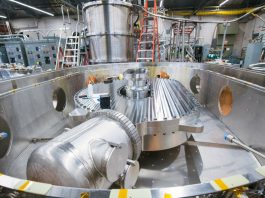Plus, the entire station doesn’t go dark—Gogoro has a built-in system that decides which or how many batteries in a station stop charging. “We know exactly which batteries to spin down, which station to spin down, how much to spin down,” says Luke. “That was all calculated in real time in the back side of the server.” It can even consolidate the power left in several batteries into one, so a customer who comes in can still leave with a fully charged battery even if the whole system is operating below capacity.
The earthquake and its aftermath in Taiwan this year put the VPP stations to the test—but also showed the system’s strength. On April 15, 12 days after the initial earthquake, the grid in Taiwan was still recovering from the damage when another power drop happened. This time, 818 Gogoro locations reacted in five seconds, reducing power consumption by 11 megawatts for 30 minutes.
Numbers like 6 MW and 11 MW are “not a trivial amount of power but still substantially smaller than a centralized power plant,” says Joshua Pearce, an engineering professor at Western University in Ontario, Canada. For comparison, Taiwan lost 3,200 MW of power supply right after the April earthquake, and the gap was mostly filled by solar power, centralized battery storage, and hydropower. But the entire Taiwanese VPP network combined, which has reached a capacity of 1,350 MW, can make a significant difference. “It helps the grid maintain stability during disasters. The more smart loads there are on the grid, the more resilient it is,” he says.
However, the potential of these battery-swap stations has not been fully achieved yet; the majority of the stations have not started giving energy back to the grid.
“The tech system is ready, but the business and economics are not ready,” Luke says. There are 10 Gogoro battery-swapping stations that can return electricity to the grid in a pilot program, but other stations haven’t received the technological update.
Upgrading stations to bi-directional charging makes economic sense only if Gogoro can profit from selling the electricity back. While the Taiwanese state-owned utility company currently allows private energy generators like solar farms to sell electricity to the grid at a premium, it hasn’t allowed battery-storage companies like Gogoro to do so.
This challenge is not unique to Taiwan. Incorporating technologies like VPP requires making fundamental changes to the grid, which won’t happen without policy support. “The technology is there, but the practices are being held back by antiquated utility business models where they provide all electric services,” says Pearce. “Fair policies are needed to allow solar energy and battery owners to participate in the electric market for the best interest of all electricity consumers.”
Correction: The story has been updated to clarify that 90%, not 10%, of Gogoro’s batteries are on the road.



